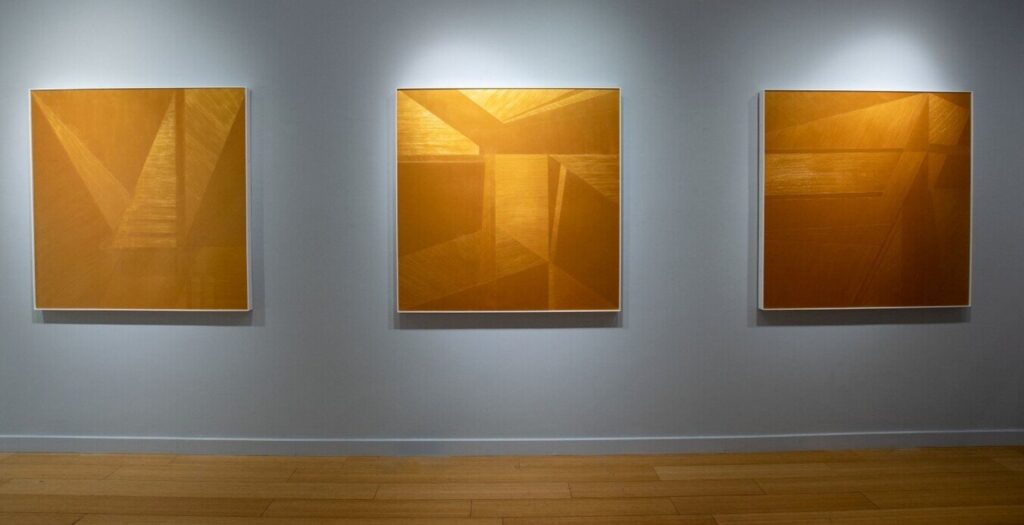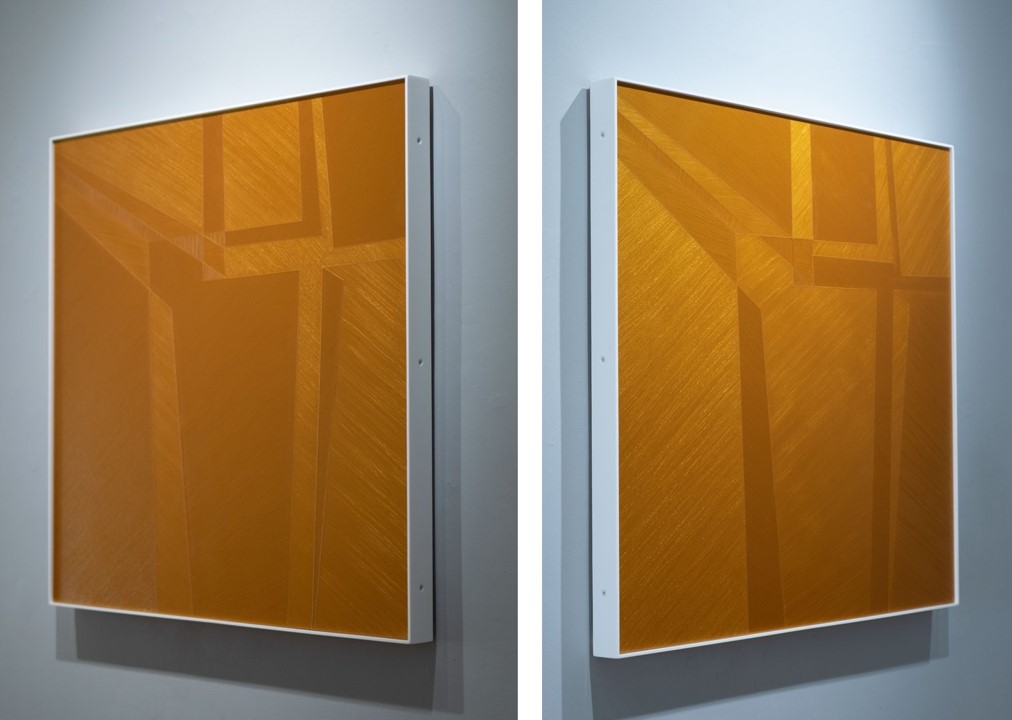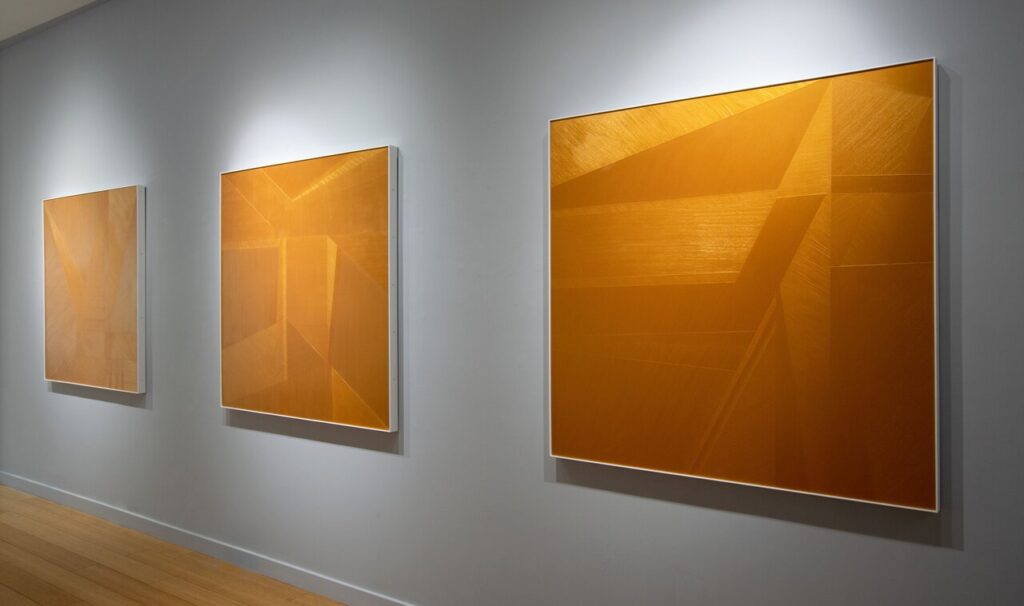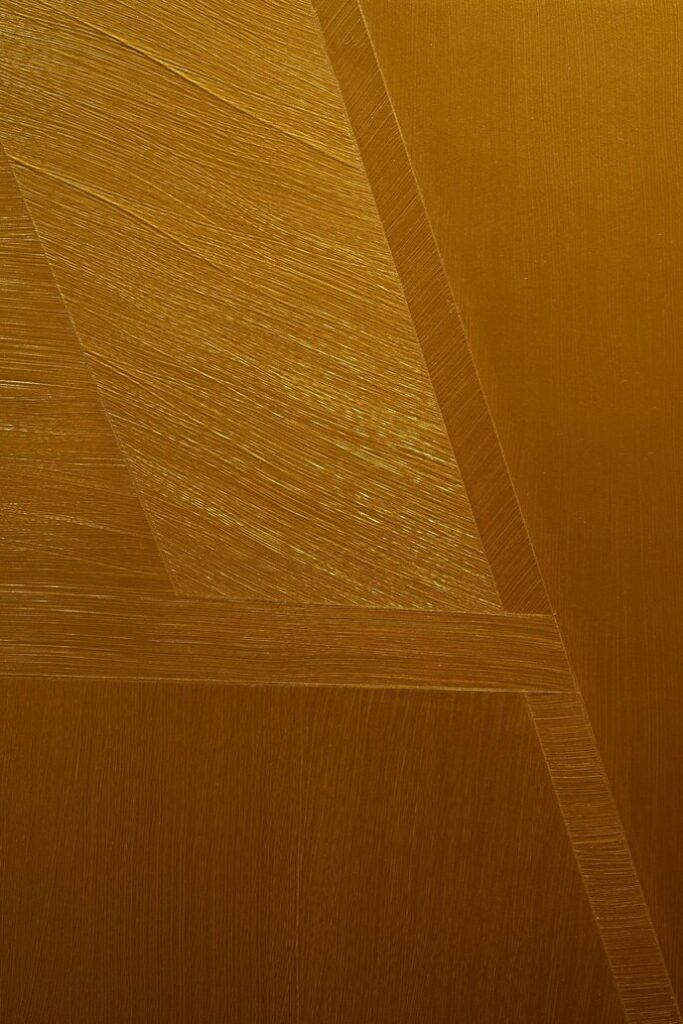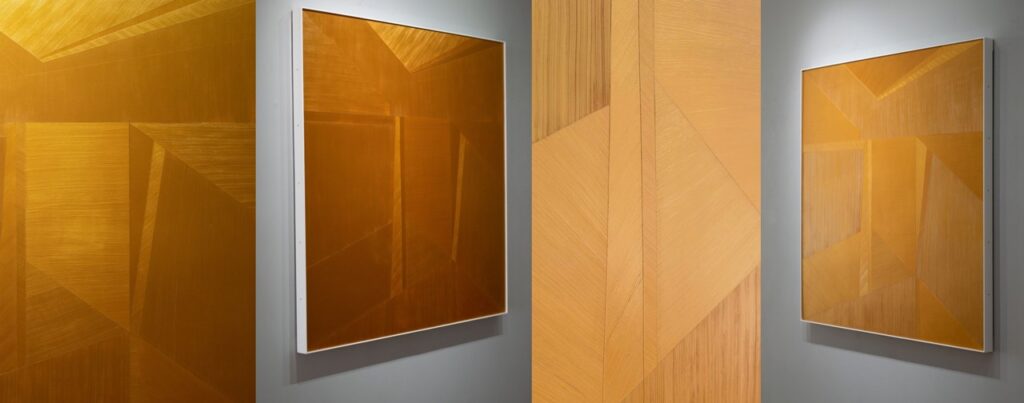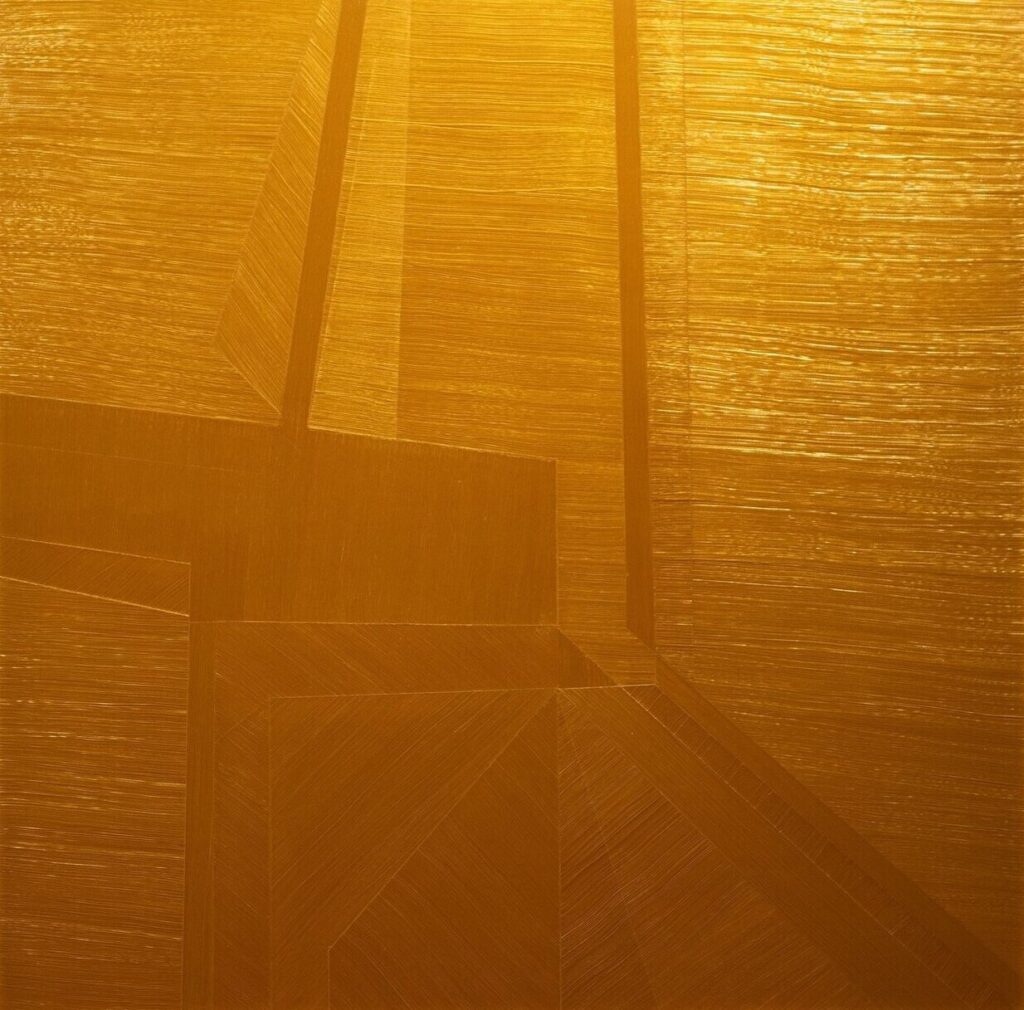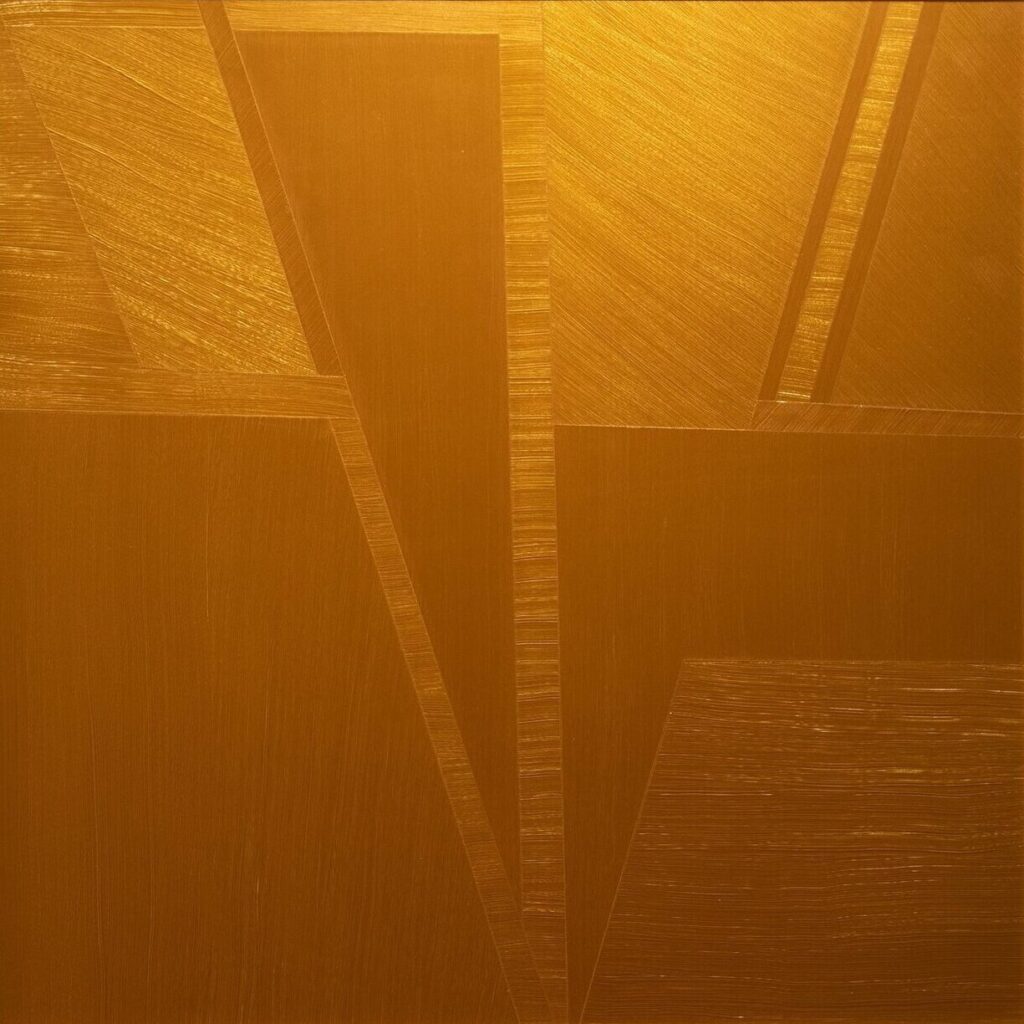Installation view of All that Glitters Isn’t at Myta Sayo Gallery
Light, as much as colour and form, is central to Kal Mansur’s art. The glow of reflected colour, the diffusion of detail through translucent surfaces, as well as the play of shadows are all integral to the impact of his work.
Kal Mansur, Search, acrylic on panel 30″ x 30″ – two views
In this new series, Mansur distills the interplay of light and surface to a succinct, minimal expression. The work in the exhibition All that Glitters Isn’t consists of glossy, gold-coloured panels. On first impression, the surfaces appear to be divided into geometric fields of varying shades of gold, some more yellow; some more brown. But move around and you will see the lighter and darker areas swap places. The colours shift depending on your point of view and the angle of light. Move in close and you’ll notice that the sharply defined geometry is textured with prominent brush marks. You’ll also notice that the paintings are completely monochrome. The appearance of different shades is solely due to the textured surface.
Installation view of All that Glitters Isn’t at Myta Sayo Gallery
The materials used are conventional. Acrylic paint is applied to birch plywood panels with a large, course bristled house painting brush. The resulting deep grooves create surfaces that reflect more light perpendicular to the brush strokes and less light in other directions. When light strikes parallel to the grooves, the surface appears darker; when the angle of the light is perpendicular, the surface is brighter.
The brush marks are varied due to the bristles of the brush and the movement of the artist’s hand resulting in a texture almost like wood grain. Mansur has employed a special formulation of acrylic medium to preserve the deep textures in the paint. Normally, it would be hard to maintain such depth of relief once the paint has cured. The various fields of paint are often separated by thin raised ridges which are the result of meticulous masking. There is an intriguing tension between the crisp, hard edge arrangement of the geometry and the looser, hand-crafted quality of the surfaces themselves.
Kal Mansur, Beacon, acrylic on panel, 30″ x 30″ (detail closeup view)
The shapes of the geometric fields invite an interpretation of perspective space within the image. But no single view is resolved. Whereas some elements suggest receding depth, other elements contradict this reading. We are left with a kind of fragmented space that folds back and forth and eventually leads back to the flat surface of the artwork.
Multiple views of Open, acrylic on panel, 48″ x 48″ x 2″
These paintings are difficult to photograph. Since the images change at every angle of view and variation in lighting, there can be no definitive photographic representation. It is impossible to capture in a single image the experience of seeing them in a room where you can move around and observe the changes. On the gallery’s website there are photos from multiple angles for each piece as well as videos which give you a good approximation of what the physical encounter is like.
Kal Mansur, Monument, acrylic on panel, 30″ x 30″
Modern abstract art has been practiced for over a century and yet it has more than its fair share of sceptics. On one hand there are the people whose ‘kids could do it’, and on the other hand critics who are more interested in the ‘cerebral’ intent than ‘retinal’ aesthetic experiences – to use Duchampian terms. For all these detractors, the belief is that abstract art came to a dead end long ago.
Scepticism is further fuelled by the fact that abstract art is hard to talk about. How much can you say that would be objectively true when the viewing experience is mostly subjective and specific to the person looking at the work? A viewer’s response is neither fixed nor universal, but rather elusive and open ended. There is no particular meaning to be decoded. The best approach to work like this is to ask yourself how it makes you feel, rather than what you think it means.
Kal Mansur, Beacon, acrylic on panel, 30″ x 30″
The intent of the abstract artist, the ideas that inspired the work, may remain hidden but this can open wider possibilities for the viewer. Mansur’s work draws on his personal background, but knowledge of his history is not required to engage with the work. What a viewer of the work gets out of it may or may not correlate with what motivated the artist. The ambiguity allows for a wider and more sustained engagement. As Kal Mansur says of his work, “If you just change the way you view something you might completely alter your perception of it.” Mansur’s ongoing technical and visual innovations demonstrate that there’s no imminent dead end here. So don’t give up on abstract art!
Mikael Sandblom
Images are courtesy of Myta Sayo Gallery.
*Exhibition information: Kal Mansur, All that Glitters Isn’t, May 15 – July 1, 2023, Myta Sayo Gallery, 1518 Dundas St West, Toronto. Gallery hours: Wed – Sat 12 – 7pm.

